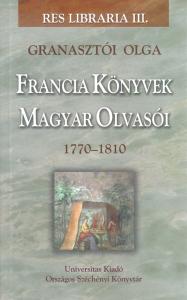
Hungarian Readers of French Books 1770–1810
Hungarian Readers of French Books 1770–1810
Reception of the Forbidden Literature in Hungary, 1770–1810
Written by Olga Granasztói
NSZL–Universitas Publishing House, Budapest, 2009., 320 pages
[Res Libraria, III., series edited by Edit Madas, István Monok, Dóra Lipták]
ISBN 978-963-200-570-6
The fast development of book and reading culture that took place in Western Europe in the second half of the 18th century reached the Central-European countries by the last thirty years, although to a lesser extent. Secular works were published in greater numbers in Hungary, too, and the first Hungarian language papers also appeared. As a result of the boost in book publishing and trade encouraged by the enlightened absolutist reforms of Joseph II, also literary life got a new momentum. It is known from history that the development of the Joseph era was set back by the severe orders of censorship issued by his successor, Francis II. Indeed, the strict measures and the isolation from Western spirit was a hindrance to the Hungarian cultural and intellectual life, but it was already impossible to suppress the interest in the news that continued arriving from abroad, especially France. Prohibited books, although with difficulties, made their way to Hungary, and an ever widening circle of readers eager to learn managed to taste the forbidden fruit.
But 18th century readers did not only read what posterity considers valuable. The author of the present work researched the entirety of French books that shaped the taste of one-time Hungarian readers with the conviction that the readers’ interest was much more varied and their taste much more mixed than explored by previous research.
So, who were the readers of French books in the last thirty years of the 18th century in Hungary? What did they read and how? The topic, already studied from so many angles before, is now revised by a specialist who used new research methods like comparativism and interdisciplinarity as the prohibited French books did not observe language or national borders. Great part of them are works by authors belonging to the international republic of literature, published by managers who did not use their mother tongue in business, sold by distributors who established international networks, and read by people whose mother tongue was not French.
Olga Granasztói offers an overall picture of the one-time reading habits of Hungarians that included the basic works of the French Revolution as well as libertine and openly erotic, strictly prohibited books. The present work analyses the library stocks of Hungarian aristocrats and the popularity of some specific works according to the sources available.
Shopping
Our publications are available in our bookshop, or can be ordered from the Publications Department of the NSZL using the contact details below: Főigazgatói Kabinet kiadványtára, Országos Széchényi Könyvtár, 1276 Budapest P.O. box 1205., phone: 06 1 232-3556, e-mail: kiadvanytar@oszk.hu.




